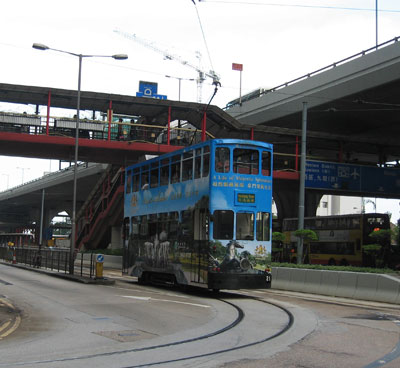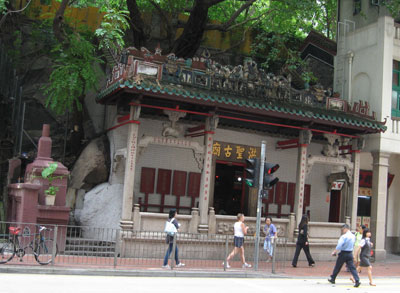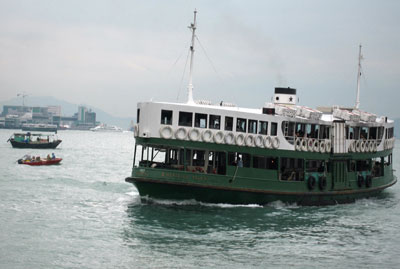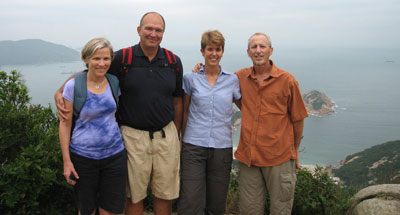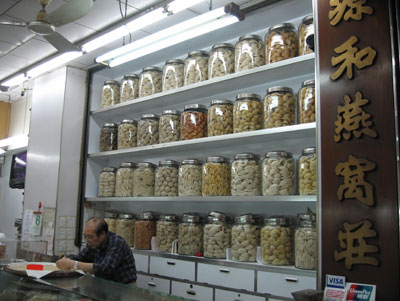Making the most of three days in Hong Kong
by Inga Aksamit, San Rafael, CA
Many travelers to Asia find themselves with a layover in Hong Kong, a thriving metropolis of seven million people where East collides with West. Reclaimed by China in 1997 but still a melting pot of international commerce, Hong Kong is awash in gleaming highrises and blinking neon signs touting some of the biggest names in business.
If you arrive in Hong Kong after a long flight en route to another Asian destination, there are worse places to sleep off jet lag and begin acclimating to the time zone and culture changes. Hong Kong has a reputation for being a very expensive place to visit, but my husband, Steve, and I found some ways to explore and enjoy without breaking the bank.
Where to stay
Lodging is likely to be your greatest expense. If you have any hotel points squirreled away in frequent-stay programs, Hong Kong is an ideal place to use them as many Western hotel chains have properties there.
On our October ’08 visit, we used Marriott points to stay at a lovely Courtyard by Marriott, which turned out to be shiny and new and unlike any Courtyard I’ve experienced in the US. A sleek and modern highrise, it was upscale, with attentive staff, many amenities and a full-service restaurant which served first-rate food (I gorged on dim sum every morning at the breakfast buffet).
Located in the Western District, adjacent to the downtown Central District, it was accessible by multiple forms of public transportation. We took the very convenient Airport Express train from the airport to downtown, then hailed a cab for the short ride to the hotel since we were not yet familiar with the tram and subway.
During our stay, we rode the historic, charming double-decker trams frequently, sometimes riding them to the end of the line and back, just to get off our feet. Running along the waterfront, they are a bargain at HK$2 (US26¢) per person.
Discovering Hong Kong
I stumbled upon Hong Kong’s tourism website while doing some pretrip research and was enthralled with the idea of completing the walking tours described there.
Several walking tours are described in a downloadable format, including detailed maps, which are easy to print and take with you. I printed three but primarily used the “Central & Western District” tour, deviating a bit to catch the Peak Tram before picking up the Wan Chai tour.
We started the walking tour near our hotel at the Western Market, noting the not-unpleasant mild odor of dried seafood that wafted through the neighborhood. Almost every shop was crammed to the rafters with innumerable varieties of dried fish, and the aroma became our wake-up call to pay attention to where we were going. When we smelled the fish odor, it meant we were near our hotel.
Proceeding along Wing Lok Street to Des Voeux Road and down Ko Shing Street, we passed through neighborhoods specializing in shops carrying specific wares, including ginseng and birds’ nests, used to ensure longevity and energy, an exotic assortment of dried fish and, finally, a dizzying array of dried herbs used in the flourishing medicinal trade.
We then entered the antiques neighborhood, but we were there too early so most of the shops were closed. More interested in sightseeing than shopping, we headed toward Man Mo Temple for a fascinating glimpse into the traditional past, the small temple overshadowed by the urban structures surrounding it.
As we entered the Taoist temple, thick clouds of fragrant smoke drifted down from cones of incense suspended from the ceiling, caressing our olfactory senses with the sweetly pungent aroma emanating from the smoldering coils.
A unique attraction
An unusual and well-known feature of Hong Kong is the longest series of outdoor covered escalators in the world (800 meters). Known as the Mid-Levels Escalators, they connect downtown to the Mid-Levels area, where many highrise residences are located.
They are in heavy use by residents, who include many expatriates, during commute hours. The escalators run downhill from 6 a.m. to 10 a.m., then uphill for the rest of the day until midnight.
We took a 20-minute ride up and observed many shops and cafés located across the narrow walkway that runs alongside the escalators. We deviated here from the walking tour in favor of riding all the way to the top, where we encountered a helpful map posted near the exit of the escalator.
Signs directed us toward the zoo and the Peak Tram. At the zoo, we walked through a lovely aviary and garden that was free of charge. The heat and humidity were building, so we rested on a bench and enjoyed the grounds for a short time.
The Peak Tram
The Peak Tram is located across the street from the zoo. It provides transportation up an exceedingly steep hill, ranging from a gradient of four to 27 degrees, for HK$49 (US$6).
The reward at the top of the 1.4-kilometer funicular railway is a beautiful panoramic view of the harbor, Hong Kong and Kowloon. From the other side, views to the south surprised us with wide swaths of green, beaches and expansive views of the South China Sea.
We enjoyed the views but didn’t enjoy running the gauntlet through the multiple escalators wending through an overcommercialized multilevel mall pulsing with music and jam-packed with jewelry, high-end international clothiers and tacky tourist knickknacks to get to the viewing platform — a minor inconvenience.
We took pleasure in the cooling breezes at the higher elevation, a welcome respite from the steaming temperatures as the sun rose higher in the sky.
Wan Chai
Descending via the Peak Tram, we made our way through the now-fetid air and walked toward Des Voeux Road to catch the tram to Wan Chai to begin the Wan Chai District walking tour. This bustling, crowded neighborhood is described as an endless series of reclamation projects, starting with the creation of the neighborhood, which used to stand in Hong Kong Harbour water.
We went down a narrow street buzzing with the activity of the Tai Yuen Street Market, filled with stalls selling food, clothing, pipes, toilets and anything else one can think of.
We had some difficulty locating the tiny Hung Shing Temple, probably due to the effects of jet lag taking over, but we were glad we persevered, as it, like the Man Mo Temple, is enchantingly out of place, wedged in between apartments on the busy street and built around a large boulder.
Star Ferry journey
We proceeded toward the harbor and passed through the Southern Playground. Becoming a bit weary, we again became distracted from the walking tour and started following signs to the Star Ferry, finding a large ferry terminal on the other side of the huge Convention Center.
Feeling drowsy and ready to get off our feet, we took a ferry (HK$2.20, or US30¢) to Tsim Sha Tsui, located across the harbor on the Kowloon side, for no reason other than to get out on the water and get another view of the city.
We disembarked from the Star Ferry on a mission to find the landmark Peninsula Hotel, still one of the world’s grandest hotels, as it has been since its opening in 1928. Located in a majestic colonial building overlooking Victoria Harbour, it is world renowned for its luxury, maintaining a fleet of 14 Rolls-Royce limos and its own helipad.
Gazing at the throne-like exterior evoked almost-forgotten memories of my first trip to Asia. Just four years old, I was being toted around by my mother en route to joining my father in Lahore, Pakistan, where we would live for the next four years, the beginning of endless adventures around the globe for our family.
Suffering from jet lag, culture shock and general toddler petulance, I reached the end of my rope during a stay at the Peninsula Hotel, diving under a white-linen-bedecked table and refusing to come out of my safe refuge. Luckily for us, the polished staff took it all in stride and coaxed me out with beautifully folded origami animals that they made on the spot, to my mother’s great relief.
The area surrounding the Peninsula Hotel has been taken over by international retailers, and I felt like we could have been at any one of a number of shopping districts in the US (Rodeo Drive in Los Angeles, Union Square in San Francisco and Kalakaua Avenue in Honolulu came to mind) — lots of energy but hardly unique.
Wrapping up our first day, we took the ferry back to the Central District and hopped on a tram to get home. We were ready for a nap but felt a sense of accomplishment, since we managed to stay up all day and see a large chunk of Hong Kong as our friends back home slumbered through the night.
Hiking in Hong Kong?
We are fortunate to have friends, Joe and Tracey, who have lived in Hong Kong for 15 years, and on our second day they showed us a side of Hong Kong I didn’t know existed. When they offered us a choice of shopping or hiking, I quickly chose hiking, not knowing what that might mean in the urban metropolis.
Tracey, Joe and their two children, Amy (12) and Neil (eight), arrived at our hotel in a taxi and directed the driver to take us to Shek O, which I easily located on the map included in our Lonely Planet guidebook. While they have a car and driver, it was easier to take a taxi due to the nonexistent parking at the trailhead.
The trailhead was well marked and we set off on the Dragon’s Back trail, a loop that took us high on a ridge on the southern end of Hong Kong Island, looking down on the same beautiful beaches we had observed from the Peak Tram. We took our time, enjoying the green, open spaces — a welcome change from the humid, bustling city we left behind.
The moderate trail had many steps and was graced with several benches along the way, providing places to pause and catch the cooling breezes. When we arrived back at the trailhead, it was only a matter of moments before we were able to hail two cabs to take us back to town.
Museum and market visits
If you have a third day in Hong Kong, as we did on our way back to the US from Vietnam, you might consider checking out some of the many museums. Tracey had been to them all and was a bit jaded since she’s lived there so long, but one museum, the Museum of Coastal Defence, stood out in her mind as unique, so we took that as a recommendation.
The Museum of Coastal Defence, converted from the Lei Yue Mun Fort, was located on the other end of the harbor from the Western District, where we were staying. Deciding that the tram was too slow, we took the subway, which is very efficient, clean and modern. From the Sheung Wan station to Shau Kei Wan it cost HK$15 (US$1.90) per person and got us within a short walk of the museum.
There were several impressive highlights at the museum, including exhibits that cover distinct periods over the 600-year history of coastal defense, from the Ming period in the 1300s to the present. Many restored relics can be seen from the trail that encircles the museum.
The museum is closed Thursdays and the first two days of the Lunar Year. It is open all other days from 10 a.m. to 5 p.m. Admission costs HK$10 per adult, with free admission on Wednesdays.
Since our trip was coming to its conclusion, we finally succumbed to the beckoning Stanley Market, previously a fishing village and now transformed into a shopper’s paradise.
We took a cab to the south end of the island and disembarked into a warren of narrow lanes lined with shops where one can find collectibles, curios, silk clothing, shoes, handbags and more. We found some mementos, bargained a little, finished our shopping for friends and family back home and didn’t mind carrying it since this was the last leg of our journey.
Summing up
On this trip, we found a kaleidoscope of sights and sounds that opened our eyes to different sides of Hong Kong. We peeked into ancient traditions, saw remnants of colonial times and drank in the excesses of modern urbanity laced with vast tracts of green space.
We left with the allure of the promise of more and a long list of things we want to experience on our next trip there.


